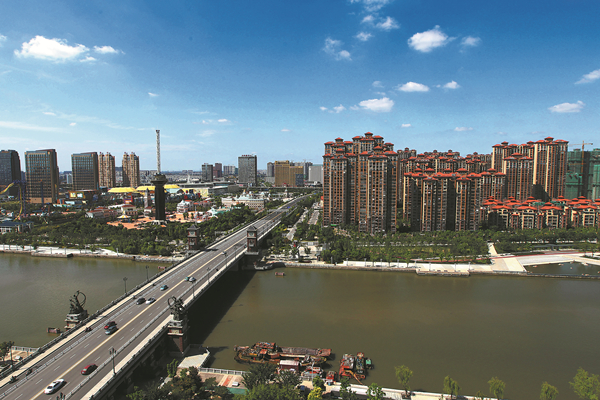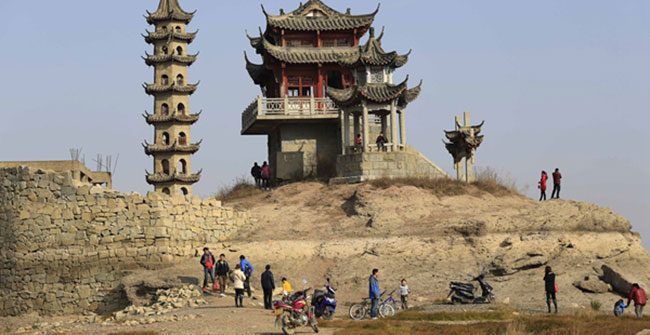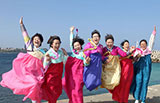Nantong grasps growth opportunities
By Ding Congrong, Chen Ke, Zheng Jianwen (China Daily) Updated: 2016-01-01 09:09City draws foreign funds, invests overseas and develops tech zones, Ding Congrong, Chen Ke and Zheng Jianwen report.
Located at the Yangtze River's mouth to the Yellow Sea and with Shanghai to its south, Nantong in East China's Jiangsu province has seized the opportunities for development generated by national strategies during the 12th Five-Year Plan (2011-15) and realized stable economic growth through further opening-up in the context of the new normal.
The strategies included the coastal development and integrated development of the Yangtze River Delta region, the Yangtze River Economic Belt and the launch of the Shanghai Free Trade Zone, and strong support for the Belt and Road Initiative.
The city has made great strides in attracting foreign investment, investing overseas and promoting the growth of its economic and technological development zones over the past five years.
 |
| More than 60 Global Fortune 500 companies have a presence in Nantong, Jiangsu province. PROVIDED TO CHINA DAILY |
Foreign investment
Nantong has approved 245 foreign-invested projects each with an investment of more than $30 million since 2011. Of those, 52 projects, including those of China Merchants Heavy Industry, Hantong Enji Heavy Industry and Hilong Offshore Oil, each have investments of more than $100 million.
More than 60 Global Fortune 500 companies, including BASF and Merck from Germany; Honeywell, Caterpillar and Tyson Foods from the United States; and SK and Hanwha Group from South Korea, have launched operations in the city.
Moreover, a number of foreign-invested projects have promoted the restructuring of related industries in Nantong.
Going global
Nantong has also pushed forward its going global strategy through tapping the international market and increasing its overseas investments, especially after China proposed the Belt and Road Initiative and the blueprint of the Yangtze River Economic Belt.
In 2011, Deeno Group, a Chinese oleochemical and cleaning products manufacturer, built a factory in Indonesia.
Local enterprises can embrace more opportunities by investing overseas in the context of the country's going global strategy, said an executive from the company.
Nantong's overseas investment and overseas contract business revenue are expected to reach $1.02 billion and $2.42 billion respectively in 2015, three times and twice the figures in 2010, according to statistics from the city's commerce department.
The city has invested a total of $3.99 billion overseas during the 12th Five-Year Plan, eight times the figure during the 11th Five-Year Plan (2006-10), and its overseas contract business revenue reached $9.79 billion, twice the figure of the previous Five-Year Plan, according to statistics.
Overseas trade
Nantong's growth in foreign trade over the past five years outperformed that of Jiangsu province and the country, statistics show.
The city's foreign trade volume is expected to increase from $30 billion in 2014 to $31 billion in 2015, accounting for 5.7 percent of the province’s total.
Moreover, the city has exported more products with high added value and increased exports to emerging markets.
Mechanical products accounted for 43.2 percent of all exports in the first three quarters of 2015, up from 42.7 percent in 2010. About 32 percent of the city’s exports were sent to emerging markets, including Africa, ASEAN member countries, Oceania and Latin America, up from 23 percent five years ago.
Compared with five years ago, 1,620 more companies in Nantong are engaged in foreign trade and the city is home to 24 large international dealers, each generating at least $100 million in exports. The number of businesses has doubled from 2010.
Zilang Software Technology, located in the Nantong Economic and Technological Development Zone, has launched eight mobile games since it was founded in 2012. One of its products has been exported to Japan and Vietnam.
Development zones
Nantong has 14 provincial-level or higher economic development zones, including four national economic and technological development zones, one national high-tech industrial park and nine provincial zones.
Occupying 5.6 percent of the city’s total area, the development zones have contributed to more than 60 percent of the government’s public expenditure and over 70 percent of the city’s foreign trade volume.
With the approval of national economic and technological zones in Hai’an, Rugao and Haimen and the Nantong high-tech industrial zone over the past five years, the city has further pushed forward reforms and opening-up and achieved innovation-driven growth.
DEA General Aviation, a manufacturer of helicopters and unmanned aircraft based in the Sutong Science and Technology Park, attracted great attention for its advanced products at the China International Aviation & Aerospace Exhibition in Zhuhai, Guangdong province, in November 2014.
Moreover, after the Xingdong Airport started operation as a first-class open port in August, the number of open ports in Nantong increased to five. The others are Nantong port, Rugao port, Yangkou port and Qidong port.
Contact the writers through dingcongrong@chinadaily.com.cn
- Hainan looks to boost visitor numbers
- Excessive emissions a big problem in 59 cities
- Tough rules will cut marine pollution
- PLA revamps command system
- Teen calls for educational reform at political meeting
- Huge investment fraud ring smashed
- Millions of ethnic people bedeviled by a dot in names
- Man found innocent of homicide after 23 years in prison
- China penalizes 27 over wrongful conviction case
- Shenzhen vows public safety drive






